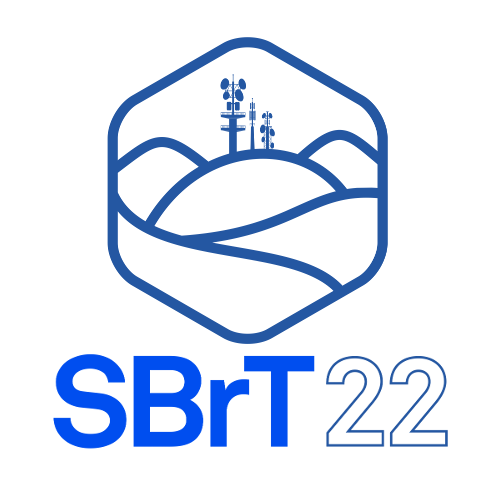
XL Simpósio Brasileiro de Telecomunicações e Processamento de Sinais
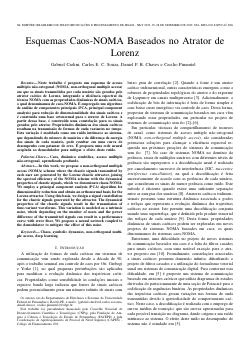
Esquemas Caos-NOMA Baseados no Atrator de Lorenz
Gabriel Carlini Monte da Silva, Carlos Eduardo Correia de Souza, Daniel P B Chaves, Cecilio Pimentel
DOI: 10.14209/sbrt.2022.1570822543
Keywords: Caos Dinâmica simbólica Acesso múltiplo não-ortogonal Aprendizado profundo
Abstract
In this work, we propose a non-orthogonal multiple access (NOMA) scheme where the chaotic signals transmitted by each user are generated by the Lorenz chaotic attractor, joining the spectral efficiency of the NOMA scheme with the dynamical properties of chaotic signals, which we denominate chaos-NOMA. We employ a principal component analysis (PCA) algorithm for dimensionality reduction and obtain an orthonormal basis for the Lorenz attractor. Using this basis, we design a signal constellation for the chaotic signals generated by the attractor. The dynamical properties of the chaotic signals result in the transmission of time-variant waveforms. This variation is modeled as a intrinsic noise, which depending on the number of users and the power difference of the transmitted signals can result in a performance curve with error floor. We propose a neural network coupled to the demodulator to mitigate the effect of this noise.Download
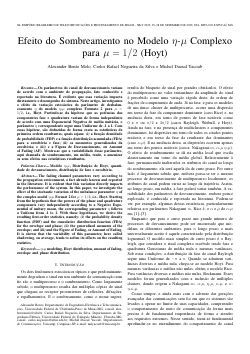
Efeito do Sombreamento no Modelo η-μ Complexo para μ = 1/2 (Hoyt)
Alexander Melo, Michel Daoud Yacoub, Carlos R. N. da Silva
DOI: 10.14209/sbrt.2022.1570822589
Keywords: Hoyt η-μ Devanescimento Sombreamento
Abstract
The fading channel parameters vary according to the propagation environment, a fact already known and reported in the literature. It is evident that this variation directly impacts the performance of the system. In this paper, we investigate the effect of the stochastic variation of the unbalance parameter η of the complex model η-µ Format 2 for µ = 1/2, i.e., Hoyt. Starting from the hypothesis that the powers of the phase and quadrature components vary independently according to a Negative Exponential of unitary mean, the corresponding parameter η follows a Uniform from -1 to 1. With these hypotheses, we derive the resulting first-order statistics, namely: (i) the probability density function (PDF) and the cumulative distribution function (FDA) for the envelope and phase; (ii) the generalized moments of the envelope; and (iii) and the Figure of Fading, or Amount of Fading. It is shown that the variability of this parameter, here called shadowing, on average, tends to soften its effects on the resulting statistics.Download

Distributed Internet of Things Applications Experimentation Tool
Jonas L de Vilas Boas, Antonio M Alberti, Joel J. P. C. Rodrigues
DOI: 10.14209/sbrt.2022.1570822755
Keywords: Blockchain Distributed Ledger Technology Internet of Things Smart Contracts
Abstract
The complementarity of distributed ledger technologies such as Blockchain and the Internet of Things has gained increasing attention in the literature. In order to facilitate the immutable validation and registration of the data collected by the devices, the so-called smart contracts have been used and distributed applications have been developed to increase the adhesion of the actors. Thus, this work presents a tool for experimentation to evaluate the performance and scalability of distributed applications in the context of the Internet of Things. The proposed tool is flexible and allows experimentation with different technologies and configurations. This work contributes to the convergence among immutable information recording, deterministic computation, and sensing of physical world quantities.Download

Algoritmo Adaptativo para Linearização de Amplificadores de RF com Alta eficiência
André Antônio Anjos, Rausley Adriano Amaral de Souza
DOI: 10.14209/sbrt.2022.1570822775
Keywords: Modelos não lineares linearização pré-correção digital algoritmos adaptativos
Abstract
Amplificadores de potência em RF são a principal causa de inserção de distorções não lineares nos sistemas de comunicação digital. Arquiteturas de amplificadores mais eficientes, tal como a Doherty, tendem a introduzir ainda mais distorções no sinal a ser transmitido. Para mitigar esse problema de forma eficiente, torna-se necessário utilizar técnicas de pré-correção digital. Neste trabalho será proposta a aplicação do algoritmo adaptativo damped Newton (DN), tradicionalmente utilizado para treinamento em redes neurais, na pré-correção digital. Comparando-se o desempenho do algoritmo proposto com outros algoritmos adaptativos já consolidados na literatura utilizando um modelo de amplificador do tipo Doherty, foi possível comprovar a superioridade do algoritmo DN em todas as métricas avaliadas.Download

Sistema de Monitoramento para Distanciamento Social Utilizando Recursos de Visão Computacional
Miriã L. N Sousa, Talía Simões dos Santos Ximenes, Rodrigo Luiz Ximenes
DOI: 10.14209/sbrt.2022.1570822820
Keywords: PDI Monitoramento Covid-19 OpenCV
Abstract
Devido à alta transmissão do vírus Sars-CoV-2 em ambientes fechados, este trabalho propõe a construção e a implementação de um sistema de monitoramento para distanciamento social, utilizando a linguagem de programação Python. A partir da análise de imagens obtidas por uma câmera e da biblioteca OpenCV (Open Source Computer Vision), foi possível realizar a detecção e mapeamento dos indivíduos, com base no Registro Acadêmico (RA), que estiveram na mesma sala/laboratório. Este procedimento é realizado com técnicas de processamento digital de imagens e tratamento de dados. Assim, de acordo com a sua movimentação indoor, é possível prever possíveis pontos de contágio no local analisado.Download
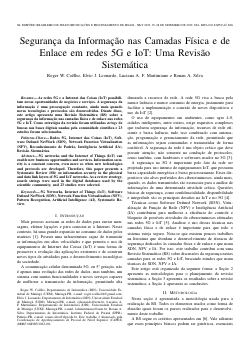
Segurança da Informação nas Camadas Físicas e de Enlace em redes 5G e IoT: Uma Revisão Sistemática
Roger William Coêlho, Elvio J Leonardo, Luciana Martimiano, Ronan Silva
DOI: 10.14209/sbrt.2022.1570822822
Keywords: Redes 5G Internet das Coisas (IoT) Software Defined NetWork (SDN) Network Function Virtualization (NFV)
Abstract
5G networks and the Internet of Things (IoT) can enable new business opportunities and services. Information security is a constant concern, even more so when new technologies and protocols are developed. Therefore, this paper presents a Systematic Review (SR) on information security in the physical and data link layers of 5G and IoT networks. As a review strategy, search strings were used in the digital databases used by the scientific community, and 23 studies were selected through RS.Download
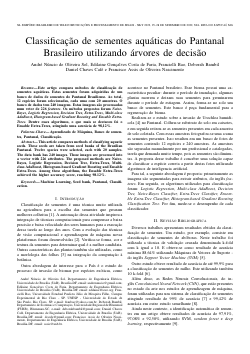
Classificação de sementes aquáticas do Pantanal Brasileiro utilizando árvores de decisão
André Sol, Edilaine Gonçalves Costa Faria, Daniel Café, Francisco Assis de Oliveira Nascimento
DOI: 10.14209/sbrt.2022.1570822835
Keywords:
Abstract
This paper propose a method for aquatic seed classificaction. These seeds are taken from seed banks of the Brazilian Pantanal. Twelve species were selected, each with 20 samples. The data bank has 240 images. Those images are processed into a vector with 226 attributes. The proposed methods are Naive-Bayes, Logistic Regression, Decision Tree, Extra-Trees, Multi-class AdaBoost, Histogram-based Gradient Boosting and Ensable Extra-Trees. Among these algorithms, the Ensable Extra-Trees achieved the higher accuracy score, reaching 98.12%.Download
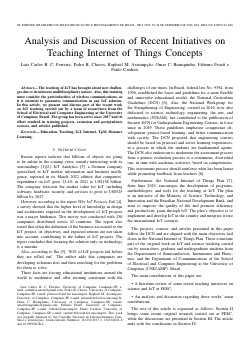
Analysis and Discussion of Recent Initiatives on Teaching Internet of Things Concepts
Luiz Carlos Branquinho Caixeta Ferreira, Pedro Chaves, Raphael M Assumpção, Omar C Branquinho, Fabiano Fruett, Paulo Cardieri
DOI: 10.14209/sbrt.2022.1570823072
Keywords: Education Teaching Internet of Things
Abstract
The teaching of IoT has brought about new challen ges due to its inherent multidisciplinary nature. Also, this training must consider the particularities of wireless communications, as it is essential to guarantee communication in any IoT solution. In this article, we present and discuss part of the recent work on IoT teaching carried out by a team of researchers from the School of Electrical and Computer Engineering at the University of Campinas, Brazil. The group has been active since 2017 and its effort resulted in training projects, extension and postgraduate courses, and articles published.Download
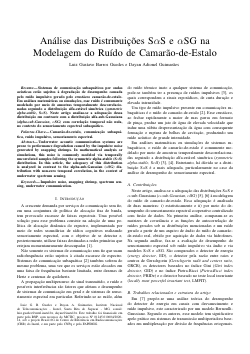
Análise das Distribuições SαS e αSG na Modelagem do Ruído de Camarão-de-Estalo
Luiz Gustavo B. Guedes, Dayan A. Guimarães
DOI: 10.14209/sbrt.2022.1570823103
Keywords: Impulsive noise Snapping shrimp Spectrum sensing Underwater communication
Abstract
Underwater acoustic communication systems are prone to performance degradation caused by the impulsive noise generated by snapping shrimps. In mathematical analysis or simulations, this noise is commonly modeled via temporally uncorrelated samples following the symmetric alpha-stable (SαS) distribution. In this article, the adequacy of this distribution is analyzed in contrast to the alpha-sub-Gaussian (αSG) distribution with non-zero temporal correlation, in the context of underwater spectrum sensing.Download

Controle de Admissão para Network Slicing Ciente de Recursos de Rede e de Processamento
Henrique Lima, Gustavo Zanatta Bruno, Felipe Hauschild Grings, Cristiano Bonato Both, Antonio M Alberti, Kleber V Cardoso, Sand Luz Correa
DOI: 10.14209/sbrt.2022.1570823144
Keywords: Admission control Network Slicing MEC
Abstract
In this work, we propose two admission control algorithms for Network Slicing aware of network and processing resources and that use overbooking techniques to increase the utilization of the 5G network infrastructure. We evaluate the proposed algorithms and compare them with an optimal solution, as well as a state of the art algorithm aware only of network resources. Results show that the proposed algorithms achieve rewards close to the optimal solution, respecting the network and processing capacity constraint and incurring SLA violations in less than 1% of cases.Download